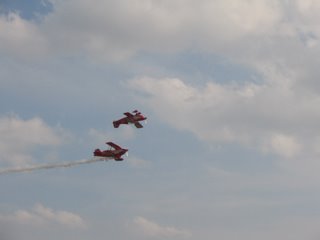Flying for a living, at last
I landed my first flying job a few hours ago.
This week has been busy and couldn't have possibly ended better.
On a high from being home with my wife, I interviewed for a CFI job on Tuesday at the flight school I trained for my private pilot certificate in 2004. The meeting went well and they invited me the next day to come back for a test flight. Before doing that, however, I had to take my single-engine CFI add-on on Thursday, which also went well. But more about that later.
Earlier this afternoon, I strapped myself into the right seat of a spanking new Cessna 172 equipped with the very impressive Garmin 1000. The glass cockpit is absolutely amazing. I won't even try to describe its capabilities since John over at Freight Dog Tales has done a brilliant job at it in various installments.
The purpose of the flight was for me to demonstrate that I could fly maneuvers and teach them at the same time. It would, however, also double as an introduction to the G1000, in which I'll get to instruct.
Ed, the chief instructor, and I took off into windy and bumpy skies. I talked him through the take-off and discussed collision avoidance techniques during the climb-out. Once at altitude, I taught slow flight, stalls and engine-out procedures. After about an hour in the air, we headed back for a couple of decent crosswind landings.
"How did he do?" another instructor involved in the hiring process asked him after our return.
"He managed not embarass himself too much," Ed replied with a grin.
And with that, they offered me a position as a flight instructor.
While I don't think it has quite sunk in yet, the feeling is amazing. To think that in two short weeks I'll be teaching students to become pilots! It's incredible. I only hope I'll manage to instill the same passion for flying that my instructors cultivated in me.
*
Since weather rolled into Virginia last week, I decided to take my last checkride back here at home in Massachusetts so as to not delay my return home.
I had the pleasure of flying with Ray Collins, the examiner who gave me my private certificate back in September of 2004.
A little after noon on a beautiful sunny, albeit bumpy day, he handed me a new instructor certificate, adding single-engine privileges to previously-earned multi and instrument ratings.
Being the romantic that I am, I found it significant that my "final" checkride (for now anyway) should take place with the examiner who first granted me the right to fly as a private pilot.
As expected, Ray taught me a lot and couldn't have been a more pleasant person to traverse the ordeal of a checkride with.
The oral focused mainly on judgement, a trait of Ray's rides. He touched on wake turbulence, land and hold short procedures, runway incursions, systems-induced emergencies, short- and soft-field landings and take-offs, spin awareness and recovery and a few more items.
The flight went well, in spite of the bumps and winds that graced the Boston area in the wake of 10 days of heavy rain.
We started off with a soft-field take-off to a soft-field landing, which I taught reasonably well but frankly could've flown better. Next came a short-field take-off to a no-flaps landing.
It was then on to the practice area for maneuvers. First in line was slow flight. After discussing the region of reverse command and maneuvering in slow flight, I demonstrated a power-off stall. Ray then took the controls to perform a botched (on purpose, of course) power-on stall. My job was to critique it, so I noted the obvious lack of right rudder, which resulted in uncoordinated flight. The perfect recipe for a spin.
We moved on to steep turns, chandelles and engine-out procedures, which were all uneventful. Ray once again took the controls and flew an S across a road. Again, I had to critique what he had done wrong.
"Frankly, I think you did a very good job," he said after I shut the plane down.
However, he noted that I allowed the bumps to affect my altitude too much in the pattern during the opening stages of the ride. That of course, would set a bad example for students and I completely acknowledged my lack of discipline during those first few minutes of the test. Nerves, of course, played a role but I should've been on top of that. As the ride progressed, I grew comfortable and flew more precisely.
Flying with Ray was an absolute pleasure. He is friendly, extremely knowledgeable and it was evident that he wanted to pass on tricks he had accumulated over the years.
I look forward to dealing with him from the other side of the fence once I recommend students to him.



















